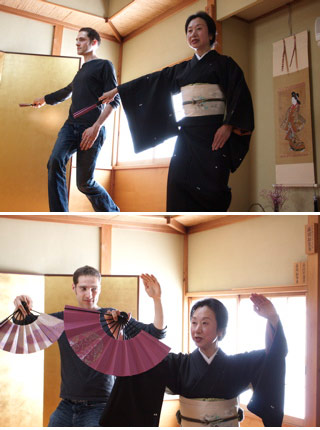She was Born in Kyoto and has over 50 years of experience. In 1981, she received the master degree of Soke-Fujima Ryu. Currently, she teaches her dance, and work choreography.
She want to teach "Wa no Kokoro," the spirits and mind of Japanese to the next generation.
Chief Instructor: FUJIMA, Kanrei
Phone: 090-9689-4503 (Contact first before visit the school)
Official web site:http://fujima.web-grow.com/
Report by Joseph
When I made my first visit to Japan in 2000, I was determined to experience as many of Japan's traditional arts as possible within the short time that I had. One thing on my list was a trip to Kabuki - traditional Japanese theatre dating back to the 1600s. Taking my seat in a packed auditorium in Ginza, I soon found myself mesmerised by the graceful movements of the actors.
Nine years later, I have finally had the opportunity to learn some of these moves for myself. A few days ago, I made my way down to Oomori, a few minutes from Shinagawa, home to the Fujima Kanjuro School of Nihon Buyo (Japanese traditional dance).
Nihon Buyo is a style of dance that was created in the edo period specifically for the providing entertainment on the stage. There are several main schools within this category of dance, one of the most popular being Fujima Kanjuro, the eighth descendent of whom is still actively teaching in Japan.
My teacher for the day, [FUJIMA, Kanrei sensei] had been practising the Fujima Kanjuro style of Nihon Buyo for over 50 years. Her moves were graceful and smooth - watching her demonstrate what I was about to learn made me realise that I, with my two left feet, had quite a challenge ahead of me!
Having learnt the technique for correctly opening and holding the sensu (fan), we moved on to the stage, where I learnt how to stand, walk, and carry out some very simple dance moves.
I must say, I felt a real sense of achievement by the end of this one-hour taster session. Whilst I still made a lot of mistakes, I felt I had been able to get a real feeling for the dance, and next time I go to kabuki I'll appreciate just how much attention and effort has gone into making every single move as smooth and graceful as it
is.
My afternoon at the Fujima Kanjuro School of Nihon Buyo was a treat I shall not forget. Sometimes, living in modern Tokyo it is only too easy to forget that there are opportunities to experience traditional Japanese culture right on our doorstep.






